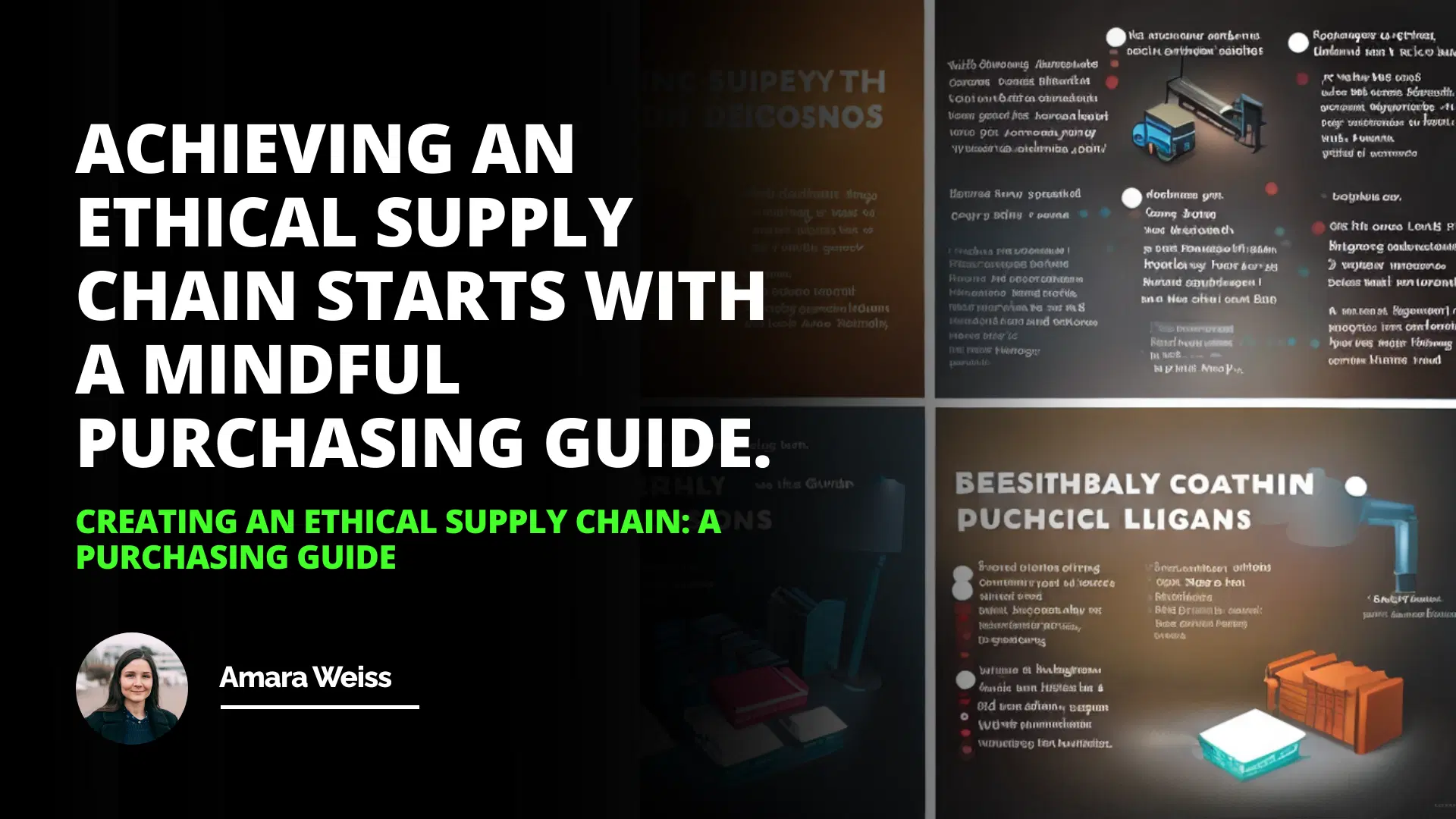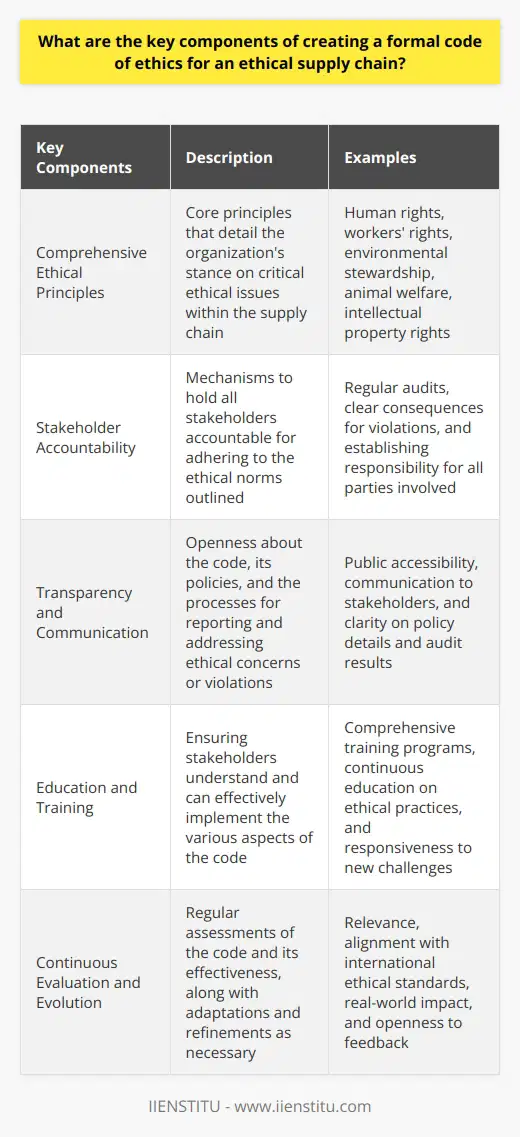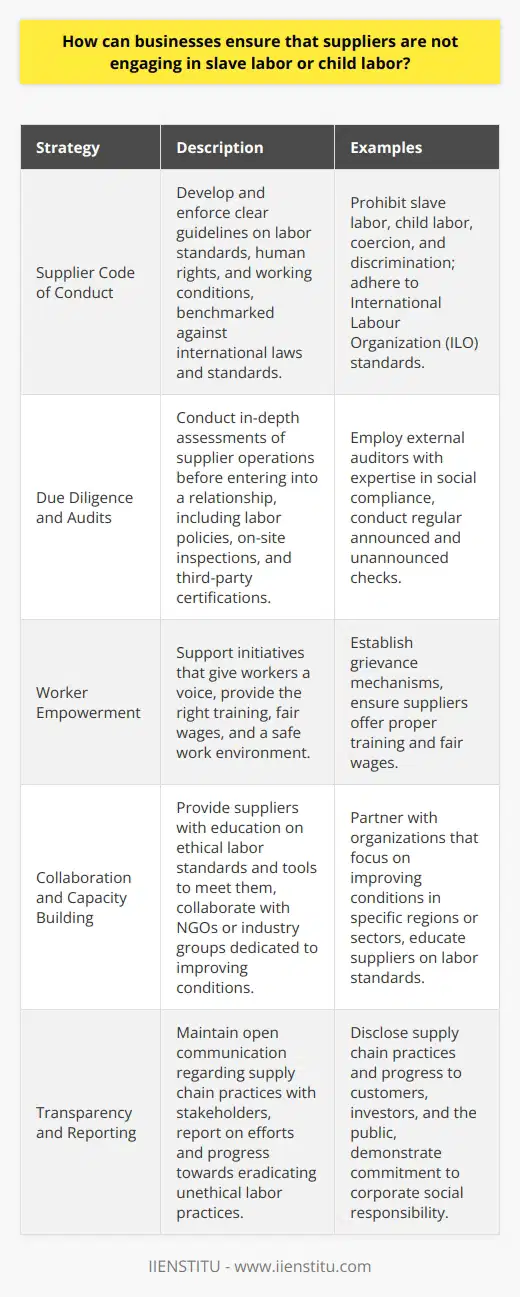
This article discusses the importance of ethical purchasing decisions and creating a formal code of ethics for the purchasing process. It outlines the various aspects of ethical purchasing, such as accepting gifts from suppliers, supporting small businesses, dealing honestly with suppliers, avoiding slave labor and child labor, complying with the law, encouraging competition, disclosing conflicts of interest, complying with payment terms, assessing how suppliers treat employees, and examining suppliers’ wages and working hours. It emphasizes the importance of creating an ethical supply chain and making sure that all decisions are made in an ethical and responsible manner.
Introduction
Importance of ethical purchasing decisions
Creating a formal code of ethics
Accepting Gifts from Suppliers
Supporting Small Businesses
Creating an Ethical Supply Chain: A Purchasing Guide
The purchasing process is an important part of any business, and it is essential to ensure that decisions are made in an ethical and responsible manner. To make sure that ethical standards are maintained, it is important to create a formal code of ethics that everyone involved in the purchasing process must follow. This article will discuss the various aspects of ethical purchasing, including accepting gifts from suppliers, supporting small businesses, dealing honestly with suppliers, avoiding slave labor and child labor, complying with the law, encouraging competition, disclosing conflicts of interest, complying with payment terms, assessing how suppliers treat employees, and examining suppliers’ wages and working hours.
I. Introduction
A. Importance of ethical purchasing decisions
The purchasing process involves big decisions that can have a significant impact on the success of a business. It is, therefore, essential that these decisions are made ethically and responsibly. This means not only considering the financial implications of the purchase but also considering the ethical implications. It is essential to ensure that the products and services purchased are not obtained through unethical means, such as slave labor or child labor. It is also essential to ensure that suppliers are treated fairly and given a fair chance to compete for contracts.
Creating a formal code of ethics
To ensure that ethical standards are maintained in the purchasing process, it is important to create a formal, written code of ethics that everyone who makes purchasing decisions must follow. This code should include specific guidelines for each situation, such as what is and is not acceptable behavior. It should also include the consequences for any violations of the code.
Accepting Gifts from Suppliers
It is essential to ensure that any gifts received from suppliers are not used to influence purchasing decisions. It is also essential to ensure that any gifts are reported by company policy.
Supporting Small Businesses
When making purchasing decisions, it is essential to consider the impact on small businesses. This means ensuring that small businesses have an equal chance to compete for contracts and are not disadvantaged due to their size.
Dealing Honestly with Suppliers
It is essential to ensure that all dealings with suppliers are open and honest. This means disclosing all relevant information and not taking advantage of any information that may be provided.
Complying with the law
In order to avoid the use of slave labor and child labor, it is essential to ensure that all suppliers comply with the law. This means ensuring that they are not engaging in any practices that are illegal or unethical.
Encouraging competition
It is essential to ensure that suppliers are given a fair chance to compete for contracts. This means ensuring that the bidding process is open and fair and that all suppliers are given an equal chance to compete.
Disclosing conflicts of interest
It is essential to ensure that any conflicts of interest are disclosed. This means disclosing any relationships or connections that may impact the purchasing decision.
Complying with payment terms
It is essential to ensure that suppliers are paid on time and by the agreed payment terms. This means ensuring that payment terms are clearly defined and that suppliers are paid promptly.
Assessing how suppliers treat employees
It is essential to assess how suppliers treat their employees. This means ensuring that suppliers comply with all relevant labor laws and that their employees are treated fairly and by local laws.
Examining suppliers’ wages and working hours
It is essential to examine suppliers’ wages and working hours to ensure they comply with local laws and regulations. This means ensuring that suppliers are not engaging in any practices that are illegal or unethical.
Conclusion
Creating an ethical supply chain is an integral part of any business’s purchasing process. It is essential to ensure that all decisions are made in an ethical and responsible manner. This means creating a formal code of ethics and ensuring that all aspects of ethical purchasing are addressed, including accepting gifts from suppliers, supporting small businesses, dealing honestly with suppliers, avoiding slave labor and child labor, complying with the law, encouraging competition, disclosing conflicts of interest, complying with payment terms, assessing how suppliers treat employees and examining suppliers’ wages and working hours.
Achieving an ethical supply chain starts with a mindful purchasing guide.
This article underlines the significance of ethical purchasing decisions and the construction of an official code of ethics for the purchasing process. It highlights aspects such as accepting gifts from suppliers, supporting smaller businesses, fair competition, and maintaining legal and ethical compliance among suppliers. To uphold these ethical standards, a formal code of ethics should be established. Transparency, honesty, workers’ rights, and wages are all critical components of this process. By examining these aspects, the article explores how integral an ethical supply chain is to any business's procurement activities. Hence, ethical decisions that lead to the creation of an official, comprehensive code are deemed essential for professionals, particularly for those with a degree in logistics and supply chain management, to adopt in their pursuit of ethical and responsible business endeavors.

Frequently Asked Questions
What are the key components of creating a formal code of ethics for an ethical supply chain?
In today’s globalized economy, businesses have an increasingly complex responsibility to ensure the ethical and sustainable sourcing of their supply chain. To this end, formal codes of ethics are an essential tool for companies, providing guidance and structure for managing business relationships with suppliers and stakeholders. A formal code of ethics is a set of principles and guidelines that outline the expected behavior of stakeholders, including suppliers, employees, and customers. This code of ethics is intended to maximize ethical business practices, and protect the interests of all stakeholders.
The key components of a formal code of ethics for an ethical supply chain are:
Clear ethical principles: A formal code of ethics should include clear and transparent ethical principles that are easy to understand and enforce. These principles should cover important topics such as human rights, labor rights, environmental protection, and sustainability.
Accountability: Companies should hold themselves and their stakeholders accountable to the ethical principles outlined in the code of ethics. This can be done through the use of internal and external audits, as well as the establishment of clear and enforceable penalties for violations of the code.
Transparency: Companies should ensure that the code of ethics is made available to all stakeholders and that the details of the code are transparent and easily accessible. This includes providing a clear explanation of the ethical principles, as well as the methods used to monitor and enforce compliance.
Training: Companies should provide training to stakeholders on the code of ethics, as well as on related topics such as audit procedures, environmental standards, and labor rights.
Continuous improvement: Companies should strive for continuous improvement in the implementation of their code of ethics. This includes regularly assessing the code for compliance with international standards, as well as developing and implementing new policies and procedures as needed.
By following these key components, companies can ensure that their code of ethics is effective in promoting ethical and sustainable sourcing throughout their supply chain. A well-designed code of ethics can also provide a competitive advantage by earning the trust of customers and other stakeholders.

How can businesses ensure that suppliers are not engaging in slave labor or child labor?
Businesses have a responsibility to ensure that their suppliers are not engaging in unethical labor practices, such as slave labor or child labor. The prevalence of these practices in the global economy is concerning, and companies must take steps to ensure that their suppliers are in compliance with ethical labor standards.
The first step is to create a code of conduct for suppliers. The code should clearly define the company’s expectations for its suppliers with respect to labor practices. It should also set out how suppliers are expected to demonstrate compliance with these standards. This code should be regularly reviewed and updated to ensure that it is in line with changes in the law and in industry standards.
The second step is to carefully vet potential suppliers to ensure that they are in compliance with the code. This should include a thorough review of the supplier’s labor policies and practices, which should be documented and monitored on an ongoing basis. It is also important to ensure that the supplier is in compliance with all applicable laws and regulations.
The third step is to establish a mechanism for monitoring the supplier’s labor practices. This should include regular audits of the supplier’s premises, as well as regular reports on the supplier’s compliance with the code. It is also important to ensure that workers are treated fairly and with respect, and that they are not subject to any form of exploitation.
Finally, businesses should work with suppliers to ensure that they are meeting the company’s expectations with respect to labor practices. This could include providing training and support to suppliers, as well as providing incentives for compliance with the code.
By taking these steps, businesses can ensure that their suppliers are not engaging in unethical labor practices, such as slave labor or child labor. This is essential for businesses to ensure that they are meeting their ethical and legal obligations, and to maintain a strong reputation in the marketplace.

What measures can be taken to ensure that suppliers are treating their employees fairly and complying with payment terms?
Ensuring fair treatment of employees and compliance with payment terms are important considerations for businesses that work with suppliers. Businesses should take a proactive approach to ensure that their suppliers are treating their employees fairly and complying with payment terms.
One of the most effective ways to ensure that suppliers are treating their employees fairly is to create and implement an effective supplier management system. This system should include a set of policies and procedures that set out the expectations for suppliers when it comes to employee treatment and payment terms. The system should also include clauses in supplier contracts that require suppliers to comply with these expectations.
Businesses should also ensure that their suppliers are compliant with local and international labor laws and regulations. This involves regularly auditing suppliers to ensure that they are compliant with applicable laws and regulations. Businesses should also work with suppliers to identify any areas of non-compliance and provide support and guidance in order to bring them into compliance.
Businesses should also have a clear payment policy in place and require suppliers to adhere to it. This policy should include a clear timeline for when payment is due and any applicable late fees or other penalties for non-payment. Additionally, businesses should monitor the payment status of their suppliers and take action if they are not adhering to payment terms.
Finally, businesses should also ensure that they are monitoring supplier performance on a regular basis. This involves conducting regular reviews of supplier performance, including an assessment of their employee treatment and payment terms. Businesses should also provide feedback and support to suppliers, so that they can improve their performance.
In conclusion, businesses should take a proactive approach to ensure that their suppliers are treating their employees fairly and complying with payment terms. This includes creating and implementing an effective supplier management system, ensuring compliance with local and international labor laws and regulations, having a clear payment policy in place, and monitoring supplier performance on a regular basis. By taking these steps, businesses can ensure that their suppliers are treating their employees fairly and complying with payment terms.

Related Courses

Supply Chain Management
Supply chain management course is a holistic, forward-looking strategy that focuses on managing an organization's supply system.

Logistics Management Course
The logistics management course covers supply chain design, inventory control, transportation planning, and more. These topics are essential for the logistical industry.

Change Management
This Change Management Course will help you understand and manage change in your workplace. The course is designed to provide you with the skills and knowledge required to successfully lead and manage change within your organization.


